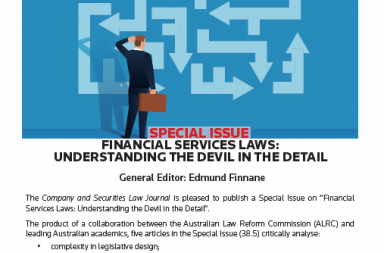*Please note that the links to the content in this Part will direct you to Westlaw AU.
To purchase an article, please email: [email protected] or contact us on 1300 304 195 (Australian customers) or +61 2 8587 7980 (international customers) during business hours (Mon-Fri, 8am-6pm AST).
The latest issue of the Australian Intellectual Property Journal (Volume 28 Part 2) contains the following material:
EDITORIAL – General Editor: David Lindsay
Articles
Avoiding an Enforcement Free-for-All in Multi-Jurisdictional IP Disputes: The Case for an Organised System of Global IP Enforcement – Michael Williams and Rebecca Smith
There is a trend towards multi-jurisdictional enforcement of intellectual property (IP) rights, given globalisation, the ubiquity of the internet and the digital economy. US courts have traditionally been prepared to exercise exorbitant jurisdiction over infringing conduct in foreign jurisdictions. A series of recent decisions of superior courts of Canada and Australia have involved the exercise of similar exorbitant powers to address infringing conduct occurring worldwide. In one instance, these types of orders have been challenged in the US courts. This potential arms race for extra-territorial rule-making in IP disputes is likely to give rise to a new conflict between courts, each exercising equivalent jurisdiction. How are these conflicts to be resolved? Private international law does not provide the necessary tools to do this. A coherent international IP system is one that is able to establish fair rules for agreed enforcement and reciprocal recognition of court orders to ensure that IP rights can effectively be enforced internationally, while avoiding imbalance in the system favouring litigants in some jurisdictions over others. The Hague Judgments Convention represents an opportunity to achieve this. However, there is opposition from certain stakeholders and a risk that the Convention’s potential benefits for international IP enforcement may be watered down.
Liability for “Invisible†Use of Trade Marks on the Internet – Vicki Huang
This article critiques the proposal to introduce a US style doctrine of initial interest confusion (IIC) into Australian trade mark law. Specifically, it rejects the proposal put forward by Mahmoud Mando in a previous issue of this journal that an IIC doctrine is needed to proscribe unseen uses of a plaintiff’s mark on the internet. It argues that the IIC doctrine is both doctrinally and normatively inconsistent with Australian trade mark law. In making this argument, this article provides an overview of current internet search technology and reviews Australian case law relating to unseen trade marks under s 120 of the Trade Marks Act 1995 (Cth). It concludes by arguing that the creation or adoption of new laws for invisible trade marks represents a form of reactionary “cyber-exceptionalismâ€, that can lead to the unnecessary distortion of robust legal principles.
Gender (Im)balance in the Patent Attorney Profession in Australia: Myths and Evidence-based Recommendations for Change – Dr Katherine Rock
Gender imbalance in the patent attorney profession is an under-reported issue. And yet, women comprise less than a third of registered patent attorneys and occupy less than 17% of senior positions in the largest private practices in Australia. Commonly purported reasons for gender under-representation are herein pitted against fact, debunking myths which blame lack of experience, lack of Science, Technology, Engineering, Mathematics qualifications or deny the issue. Indeed, research suggests that the real causes may be far more insidious.
For the PDFÂ version of the table of contents, click here: AIPJ Vol 28 No 2 Contents.
Click here to access this Part on Westlaw AU
For general queries, please contact: [email protected].

